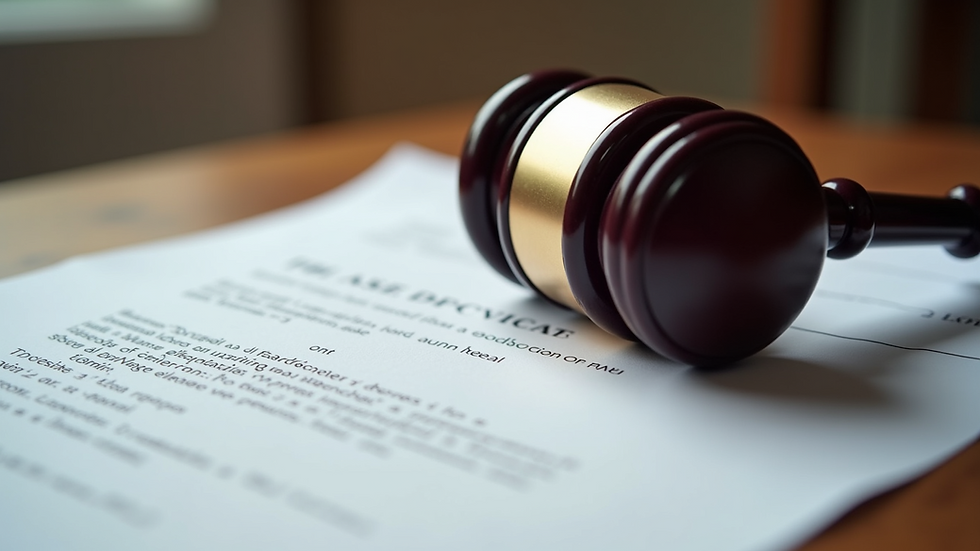Essential Strategies for Ensuring Nonprofit Liability Protection
- Derrick Danzel Days II Corporation

- Aug 13
- 4 min read
Nonprofit organizations play a vital role in our communities, providing essential services and support to those in need. However, with great responsibility comes significant risk. Nonprofits face various legal challenges, making liability protection crucial for their sustainability and effectiveness. In this post, we will explore essential strategies that nonprofits can implement to safeguard themselves against potential liabilities.
Understanding Nonprofit Liability
Liability refers to the legal responsibility an organization has for its actions and decisions. For nonprofits, this includes risks related to employee misconduct, accidents at events, and much more. Understanding the types of liabilities that can affect your organization is the first step in protecting it.
Nonprofits can face various liabilities, including:
General Liability: This covers bodily injury, property damage, and personal injury claims. For example, if a visitor trips at your event and gets injured, general liability insurance would cover that claim.
Professional Liability: This pertains to claims arising from professional services provided by the nonprofit. If, for instance, your organization offers financial advice and a client claims they suffered a loss due to your guidance, professional liability insurance would be key.
Directors and Officers Liability: This protects board members from claims related to their decisions and actions. Research indicates that about 1 in 3 nonprofit directors may face a lawsuit in their tenure. This coverage is crucial to encourage individuals to serve on your board without the fear of personal financial ruin.
By recognizing these potential liabilities, nonprofits can take proactive steps to mitigate risks.

Implementing Comprehensive Insurance Coverage
One of the most effective ways to protect your nonprofit from liability is through comprehensive insurance coverage. Various types of insurance can help shield your organization from diverse risks:
General Liability Insurance: This is essential for any nonprofit, covering claims related to accidents, injuries, and property damage. For instance, an average claim under general liability can range from $30,000 to $60,000.
Professional Liability Insurance: If your nonprofit offers professional services, this insurance can protect against claims of negligence or malpractice. For example, a case study by the Nonprofit Risk Management Center shows that nonprofits providing counseling without this coverage can face judgments exceeding $1 million.
Directors and Officers Insurance: This coverage is crucial for protecting board members from personal liability related to their decisions. It reassures leadership that their commitment to the organization will not put their personal assets at risk.
Event Insurance: If your nonprofit hosts events, consider event insurance to cover potential liabilities that may arise during these gatherings. Consider that festivals can face risks like severe weather or vendor disputes; having this insurance can save your organization substantial costs.
By investing in the right insurance policies, nonprofits can ensure they are prepared for unexpected challenges.
Establishing Strong Policies and Procedures
Creating and enforcing strong policies and procedures is another key strategy for liability protection. These guidelines should cover various aspects of your nonprofit's operations, including:
Employee Conduct: Set clear expectations for employee behavior and outline consequences for misconduct. For example, an organization may implement a zero-tolerance drug policy that includes mandatory drug testing.
Volunteer Management: Develop policies for recruiting, training, and supervising volunteers. A study found that clear onboarding increases volunteer retention rates by up to 43%.
Safety Protocols: Implement safety measures for events and activities to reduce the likelihood of accidents. Ensuring that all volunteers know emergency procedures can decrease the risk of injury.
Crisis Management: Prepare a crisis management plan to effectively address potential emergencies. Organizations with crisis plans can respond 50% faster to incidents, according to the Crisis Management Institute.
By having well-defined policies in place, nonprofits can reduce the risk of liability and demonstrate their commitment to responsible governance.

Training and Education
Education is a powerful tool in preventing liability issues. Providing training for staff and volunteers on relevant topics can significantly reduce risks. Consider the following areas for training:
Legal Compliance: Ensure that everyone understands the laws and regulations that apply to your nonprofit. For instance, lack of knowledge about anti-discrimination laws can lead to lawsuits.
Risk Management: Teach staff and volunteers how to identify and mitigate potential risks in their roles. Training that focuses on safety protocols can reduce incidents by an estimated 30%.
Crisis Response: Train your team on how to respond effectively in emergencies or crises. Regular drills and simulations ensure that your team is prepared, which can decrease response times substantially.
Regular training sessions not only enhance knowledge but also foster a culture of accountability and responsibility within the organization.
Continuous Risk Assessment
Conducting regular risk assessments is essential for identifying potential vulnerabilities within your nonprofit. This process involves evaluating your organization’s operations, programs, and events to pinpoint areas of risk.
Consider the following steps for effective risk assessments:
Identify Risks: Gather input from staff, volunteers, and board members to identify potential risks. Surveys can help capture insights from diverse stakeholders, increasing awareness.
Evaluate Impact: Assess the potential impact of each identified risk. For example, evaluate scenarios of event cancellations due to unforeseen circumstances, understanding how it would affect funding and community trust.
Develop Mitigation Strategies: Create action plans to address and mitigate the identified risks. This could include adjusting processes to improve volunteer safety during events, which can historically lower incident rates by 22%.
Review and Update: Regularly review and update your risk assessment. Changes in legislation or policies within your nonprofit may necessitate new mitigation strategies.
By staying proactive in risk management, nonprofits can better protect themselves from liability.

Ensuring liability protection is a critical aspect of running a successful nonprofit organization. By understanding the types of liabilities, implementing comprehensive insurance coverage, establishing strong policies, providing training, and conducting regular risk assessments, nonprofits can significantly reduce their exposure to legal challenges.
As you navigate the complexities of nonprofit management, remember that proactive measures can safeguard your organization, allowing you to focus on your mission. By prioritizing liability protection, you can ensure that your nonprofit continues to thrive and serve the community effectively.











Comments